The modern wheelchair provides the wheelchair user tremendous mobility and independence. This ability transfers into more opportunities for solo business and pleasure travel. Sometimes these trips require carrying a fair amount of luggage and gear.
The problem arises when wheelchair users attempt to apply able-bodied luggage systems such as rolling suitcases to wheelchair travel, or alternatively carry a large backpack on their back. Only small suitcases are able to balance on the wheelchair user’s lap, and towing a large rolling suitcase risks a backward fall. A wheelchair user needs significant trunk control to handle the weight of a heavily loaded backpack. So what do you do when you have a lot of stuff to carry combined with a maneuverable but “tippy” wheelchair?
I am a T5 paraplegic. When I travel and need to bring a “lot of stuff”, I use a six-bag system. Six bags may sound like too many, but there is a method to the madness.
- One small pouch contains all wheelchair-related tools and supplies such as a spare inner tube, tire irons, Allen wrenches, lights, etc.
- I use my everyday knapsack for carrying keys, glasses, and other personal items.
- I use a medium-sized cylindrical duffel bag for clothes and/or gear.
- I use a rectangular bag with compartments for clothes and/or gear.
- I use a medium-sized backpack for more clothes and/or gear.
- I use a large hockey duffel bag for the consolidation of airline baggage.
For airline travel, in order not to exceed the fifty-pound weight limit for a checked bag, I would put 25lbs in the Cylindrical Bag, 25 lbs in Rectangular Bag, and the remainder in the Backpack as a Carry-On as necessary. The Knapsack becomes the Personal-Item.
When I am on the move, I use the following setup:
- The Pouch hangs under my seat.
- The Everyday Knapsack goes on the back of my wheelchair.
- The Cylindrical Duffel bag is placed on my feet and fastened securely to the front of my wheelchair.
- The Rectangular Bag goes on the Cylindrical Duffel and my knees.
- The Backpack goes on the back of my wheelchair over the Knapsack.
- The Large Duffel bag is stored in any one of the other bags as most convenient.
The benefit of this multi-bag carrying method is that the Center of Gravity of the wheelchair is not dramatically changed. This means that I am still able to pop and maintain wheelies for rough terrain and jump down curbs as needed. Since the Rectangular Bag is not pressed up against my chest, I am able to lean forward for going up ramps and other inclines. On a side note, if a bag that I am carrying on my lap restricts my forward lean, I have found that going up backward works very well.
In the event I was traveling from place to place with all my luggage and gear (i.e. backpacking through Europe) I would consolidate to a front Cylindrical Duffel, a rear Backpack, the under seat Pouch, and use a front Fanny Pack for items that need to be readily available such as money, phone, and camera. Valuables such as Passport and Cash go in a Hanging Pouch under my shirt for added security.
As long as the front Cylindrical Bag is tightly fastened this system is very stable and mobile. I have used this system in Europe, South Korea, and Venezuela all while traveling solo.
For those that don’t feel that their feet make a stable enough platform to support the Cylindrical Bag, there are commercially available Folding Forks designed for that specific purpose.
In summary, bungee cords and duffel bags beat hard suitcases for wheelchair traveling almost every time.

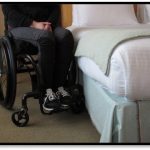
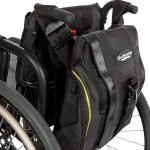


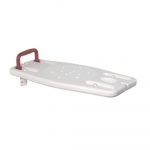
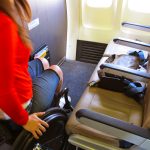


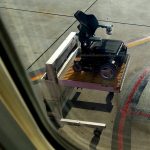

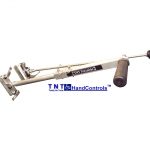



Brilliant! Thanks for the suggestion and accompanying photo!
Hi
I have used a chair for 34 years since an injury. I have now invented wheelchair luggage a system designed for wheelchair users. Feedback very welcome, check it out http://www.phoenixinstinct.com
Andrew
Hi Eric
Brilliant to see your baggage configurment. I’m going to the States from London, UK for Christmas and want to go from my float on the bus and then on the tube to the airport so need to find a way of carrying my luggage as you do above on my wheelchair. Do you have any other more close-up pictures? I’d love to see them. Thank you!!!! Jane
Jane, the trick to carrying luggage is finding a combination of soft bags that work best with your particular wheelchair.
The main concept is to use bungee cords or straps that allow you to maintain the center of balance of your WC. That means not too rear tippy and not too much weight on the front wheels.
It takes some experimentation to see what configuration works best. Feel free to contact be directly via erik@not-me.org
can you plz put some bigger pics esp of front bag and how its attached one can hardly see anything in what youve put up its so small
I talked to Erik, and he said he just used bungee-cords to fasten the bags after fitting them in the best space.
Hi Erik
This is really useful, I have been wondering how we are going to transport our luggage whilst travelling with a wheelchair. I guess it’s all about planning and organisation.
Actually just read it properly and it is available to buy. Yay!
I’m very glad to read this. I have mobility and pain challenges and I tend to stay at home far too much because I feel out of my depth in a wheelchair. I loved travelling when I was younger when I was mobile. I’ve been wondering how I could carry luggage. Thank you for sharing your tips.
What size bungee cords do you use to secure your bags?
A short one to keep that bag close! One with a standard width is good. I wouldn’t use those extra thin types.